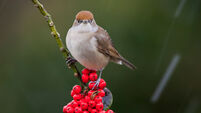Work with the weather: The dogwoods, willows, and irises that thrive in waterlogged Irish gardens

It's all about using the right plant in the right place and working with what we have and not against it. Darmera Peltata revel in damp ground. They’re like the big, showy foliage plants of a lush, misty valley somewhere far more exotic than our back garden.
IF YOU feel like you’ve been living in a rain cloud for the past fortnight, you’re not alone. Gardens across the country are soaked to the skin, lawns have the consistency of wet sponge cake, and even the ducks are looking for higher ground.
Some plants are happy, though, and for every one of us gardeners groaning at the weather forecast, there’s a dogwood or a willow rubbing its horticultural hands together and saying: “I’m loving it.”
Dogwoods, with their fiery winter stems, practically glow against a grey sky and they adore damp conditions. The richer the soil moisture, the brighter they seem to be and right now they are in their element.
Willows, too, thrive in the sort of ground that squelches underfoot. They’re made for it, their roots perfectly adapted to draw oxygen even from waterlogged soils. If you’ve ever planted a willow in a dry spell, you’ll know they sulk until the heavens open. At this time of year, they look positively invigorated.
Once again, it’s all about using the right plant in the right place and working with what we have and not against it.
Some of the irises, such as the Japanese irises, were born for wet meadows and marsh edges and, though they’re dormant now, this rain is quietly stocking their reservoirs for a dazzling show next summer.
Rodgersias and Darmera are others that revel in damp ground. They’re like the big, showy foliage plants of a lush, misty valley somewhere far more exotic than our back garden. Astilbes, too, with their feathery plumes of colour in early summer, are often dismissed as fussy but all they want is plenty of water. They don’t just tolerate wet ground, they adore it.
So while the rest of the garden looks a little bedraggled and you’re eyeing the rain gauge with fear, remember that not all is lost as, for some plants, this is a rare treat.
Of course, plenty of gardeners have been contending with more than just dampness recently. Flooding, or even prolonged waterlogging, brings its own headaches and it can be hard to know what to do or what not to do when the garden is under water or close to it.
The good news is that most plants are more resilient than we give them credit for and the worst thing you can do is panic.
One of the first things to understand is that saturated soil is fragile. Think of it like a soaked sponge — if you walk on it, you will squeeze out what little air remains, compacting the structure and making it harder for roots to breathe later. That means the best immediate action is often to do nothing. Try to avoid walking or digging on very wet ground unless you absolutely must.
When containers sit directly on a hard surface during very wet weather, they can’t drain properly and the roots inside start to suffocate. So, if you have pots sitting on patios or decking, lift them onto pot feet or even just a couple of stones.
Keep an eye, too, on plants in containers that normally like good drainage. If leaves start yellowing or dropping suddenly, it could be an early sign of root rot, so move them under cover temporarily if you can or at least out of the worst of the deluge.
For those whose gardens have genuinely flooded, don’t rush out the second the water retreats to start tidying or replanting. Let the soil recover its structure first. Plants can surprise you; many will come back once the soil oxygen levels return to normal.
Tempting as it might be, don’t be too quick to feed plants in the aftermath. Stressed roots need time, not nutrients, and adding feeds now can do more harm than good.
Once there’s a break in the weather, which there surely will be, take the opportunity to prepare for more as a bit of preparation now will make a huge difference to how the garden copes over the coming months.
Overgrown climbers that have had a growth spurt during the warm, wet autumn may now be heavy and vulnerable to strong winds. Tie in any loose stems on roses, jasmine, honeysuckle, and climbers on pergolas or trellises before a storm does the job for you.
Staking is another small job that pays off handsomely. Anything tall and slightly top-heavy, like newly planted trees, can be damaged by winter gales. Check stakes and ties, replace anything that’s rubbing or too tight, and make sure supports haven’t rotted at the base.
Maybe not technically a garden job but cast an eye over gutters and downpipes. A blocked gutter creates waterfalls where you don’t want them, saturating beds. Clear out leaves and debris to prevent bigger problems later. The same goes for paths and patios; moss and algae grow at breakneck speed in weather like this and become treacherous. A quick clean now makes the garden safer and brighter.












